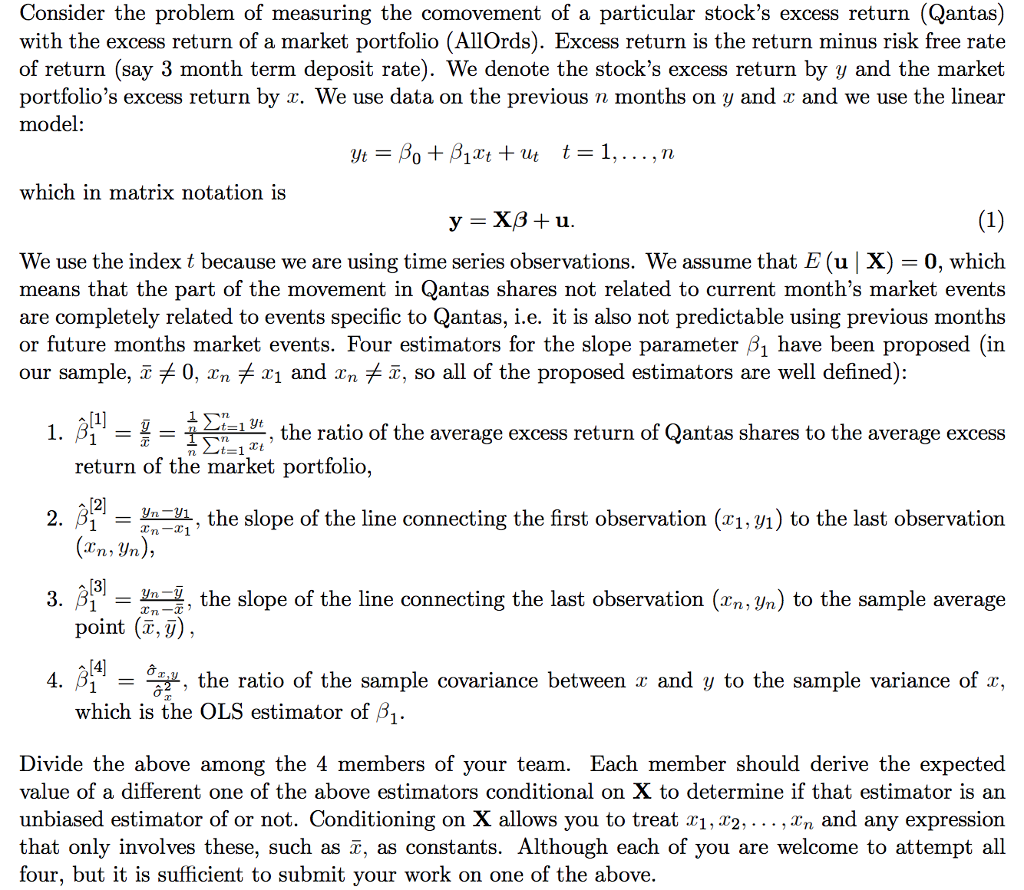Answered step by step
Verified Expert Solution
Question
1 Approved Answer
Consider the problem of measuring the comovement of a particular stock's excess return (Qantas) with the excess return of a market portfolio (AllOrds). Excess return

Consider the problem of measuring the comovement of a particular stock's excess return (Qantas) with the excess return of a market portfolio (AllOrds). Excess return is the return minus risk free rate of return (say 3 month term deposit rate). We denote the stock's excess return by y and the market portfolio's excess return by x. We use data on the previous n months on y and r and we use the linear model which in matrix notation is We use the index t because we are using time series observations. We assume that E (u|X) -0, which means that the part of the movement in Qantas shares not related to current month's market events are completely related to events specific to Qantas, i.e. it is also not predictable using previous months or future months market events. Four estimators for the slope parameter P have been proposed (in our sample, 0, xnx1 and xnx, so all of the proposed estimators are well defined): 1. -x-1 Li-in, the ratio of the average excess return of Qantas shares to the average excess return of the market portfolio 2. B1the lope of the line connecting the first observation (i,n) to the last observation 3. A1 - 7n, the slope of the line connecting the last observation (n, Jn) to the sample average 2 point (x,y). 4. 1-]-Fr , the ratio of the sample covariance between and y to the sample variance of x, which is the OLS estimator of 31. Divide the above among the 4 members of your team. Each member should derive the expected value of a different one of the above estimators conditional on X to determine if that estimator is an unbiased estimator of or not. Conditioning on X allows you to treat r1, r2, , Tn and any expression that only involves these, such as , as constants. Although each of you are welcome to attempt all four, but it is sufficient to submit your work on one of the above Consider the problem of measuring the comovement of a particular stock's excess return (Qantas) with the excess return of a market portfolio (AllOrds). Excess return is the return minus risk free rate of return (say 3 month term deposit rate). We denote the stock's excess return by y and the market portfolio's excess return by x. We use data on the previous n months on y and r and we use the linear model which in matrix notation is We use the index t because we are using time series observations. We assume that E (u|X) -0, which means that the part of the movement in Qantas shares not related to current month's market events are completely related to events specific to Qantas, i.e. it is also not predictable using previous months or future months market events. Four estimators for the slope parameter P have been proposed (in our sample, 0, xnx1 and xnx, so all of the proposed estimators are well defined): 1. -x-1 Li-in, the ratio of the average excess return of Qantas shares to the average excess return of the market portfolio 2. B1the lope of the line connecting the first observation (i,n) to the last observation 3. A1 - 7n, the slope of the line connecting the last observation (n, Jn) to the sample average 2 point (x,y). 4. 1-]-Fr , the ratio of the sample covariance between and y to the sample variance of x, which is the OLS estimator of 31. Divide the above among the 4 members of your team. Each member should derive the expected value of a different one of the above estimators conditional on X to determine if that estimator is an unbiased estimator of or not. Conditioning on X allows you to treat r1, r2, , Tn and any expression that only involves these, such as , as constants. Although each of you are welcome to attempt all four, but it is sufficient to submit your work on one of the above
Step by Step Solution
There are 3 Steps involved in it
Step: 1

Get Instant Access to Expert-Tailored Solutions
See step-by-step solutions with expert insights and AI powered tools for academic success
Step: 2

Step: 3

Ace Your Homework with AI
Get the answers you need in no time with our AI-driven, step-by-step assistance
Get Started


